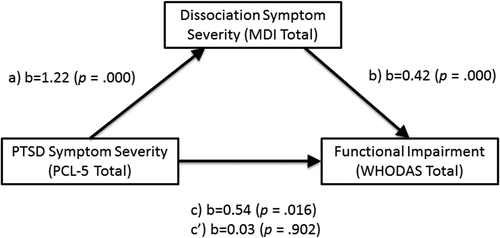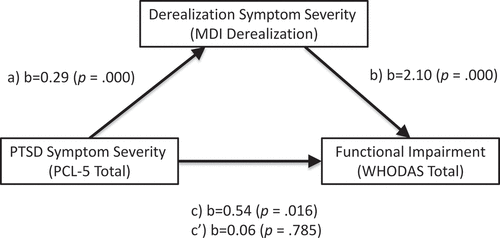Figures & data
Table 1. Demographic characteristics of the study sample.
Table 2. Correlations (Pearson’s r) between functional impairment and PTSD and associated symptom dimensions (N = 62 for all variables except for ACE-Q, N = 59).
Table 3. Clinical characteristics of study sample and comparison of clinical measures and exposure to ACEs between military members/veterans and first responders.
Table 4. Correlation matrix for dissociation symptom severity (MDI Total), PTSD symptom severity (PCL Total), and functional disability (WHODAS Total), N = 62 (Pearson’s r reported).
Table 5. Mediation effects of dissociation symptom severity (MDI Total) on the relationship between PTSD symptom severity (PCL Total) and functional disability (WHODAS Total), N = 62.
Figure 1. Depiction of the mediation model where dissociative symptoms (MDI Total) mediate the relation between PTSD severity and functional impairment. The effect of PCL Total on change in WHODAS Total when MDI Total is introduced as a mediator (c’) is nonsignificant.
b = unstandardized coefficients; a = effect of PCL Total on change in MDI Total; b) effect of MDI Total on change in WHODAS Total; c = the total effect; c’ = the direct effect MDI, multiscale dissociation inventory; PCL-5, PTSD checklist for DSM-5; WHODAS, World Health Organization Disability Assessment Schedule 2.0.

Table 6. Correlation matrix for derealization symptoms (MDI derealization), PTSD symptom severity (PCL Total), and functional disability (WHODAS Total), N = 62 (Spearman’s rho reported).
Table 7. Mediation effects of derealization symptoms (MDI derealization) on the relationship between PTSD symptom severity (PCL Total) and functional disability (WHODAS Total), N = 62.
Figure 2. Depiction of the mediation model where derealization symptoms (MDI derealization) mediate the relation between PTSD severity (PCL Total) and functional impairment (WHODAS Total). The effect of PCL Total on change in WHODAS Total when MDI derealization is introduced as a mediator (c’) is nonsignificant.
b = unstandardized coefficients; a = effect of PCL Total on change in MDI derealization; b) effect of MDI derealization on change in WHODAS Total; c = the total effect; c’ = the direct effect MDI, Multiscale dissociation inventory; PCL-5, PTSD Checklist for DSM-5; WHODAS, World Health Organization Disability Assessment Schedule 2.0.

